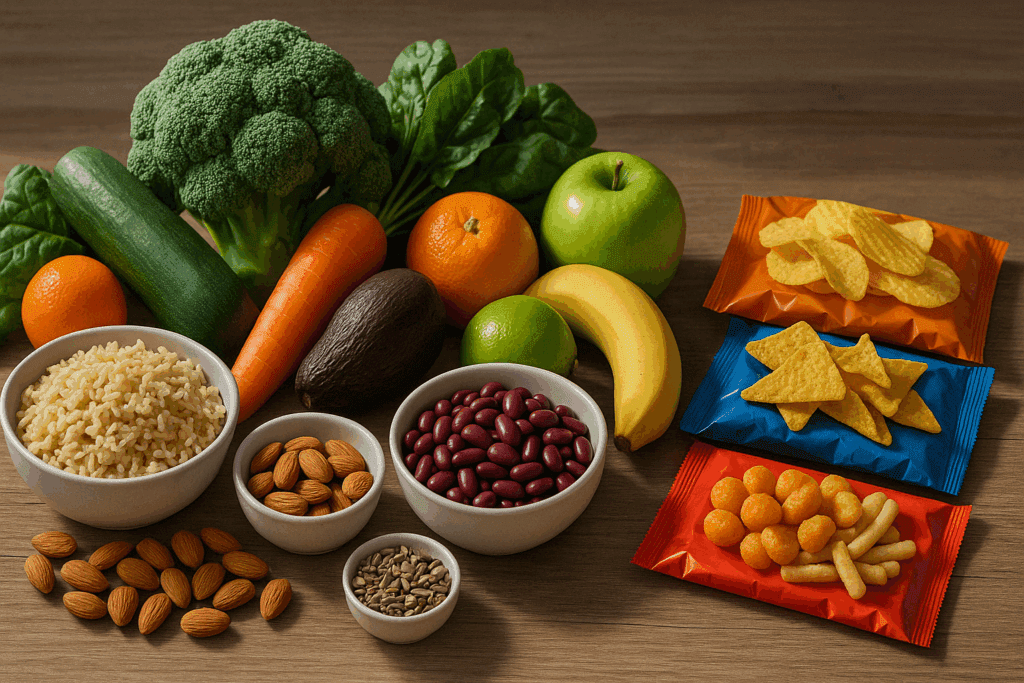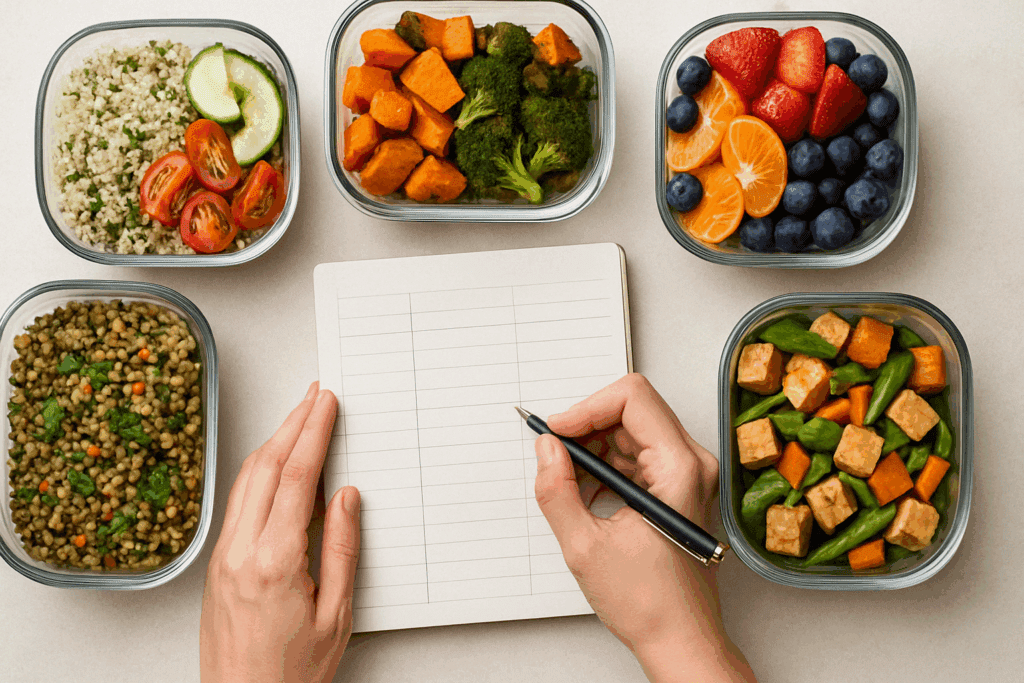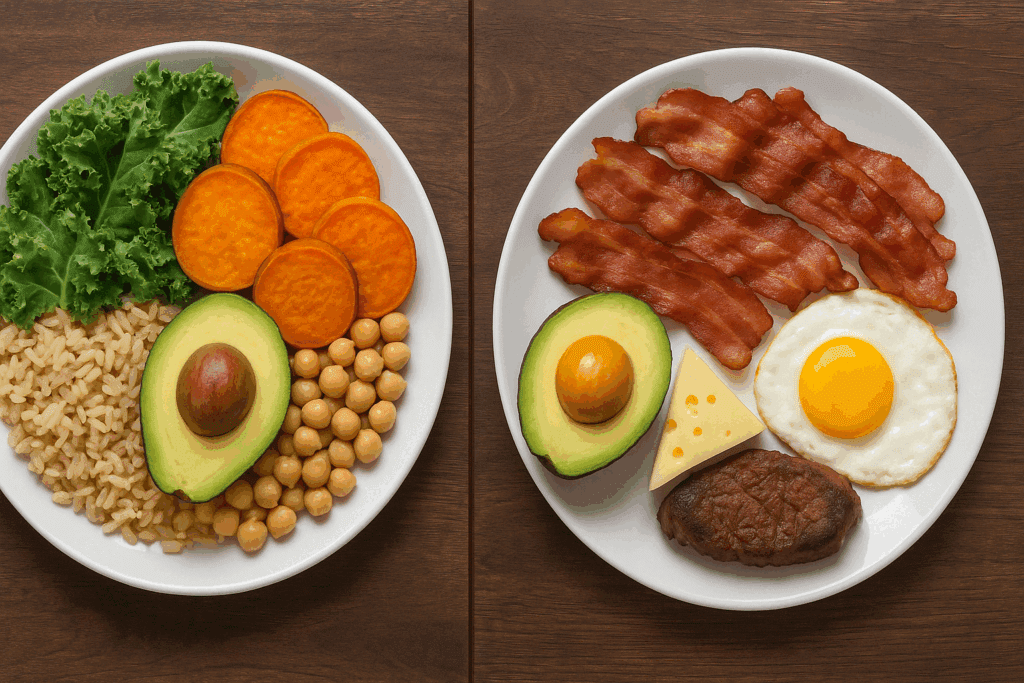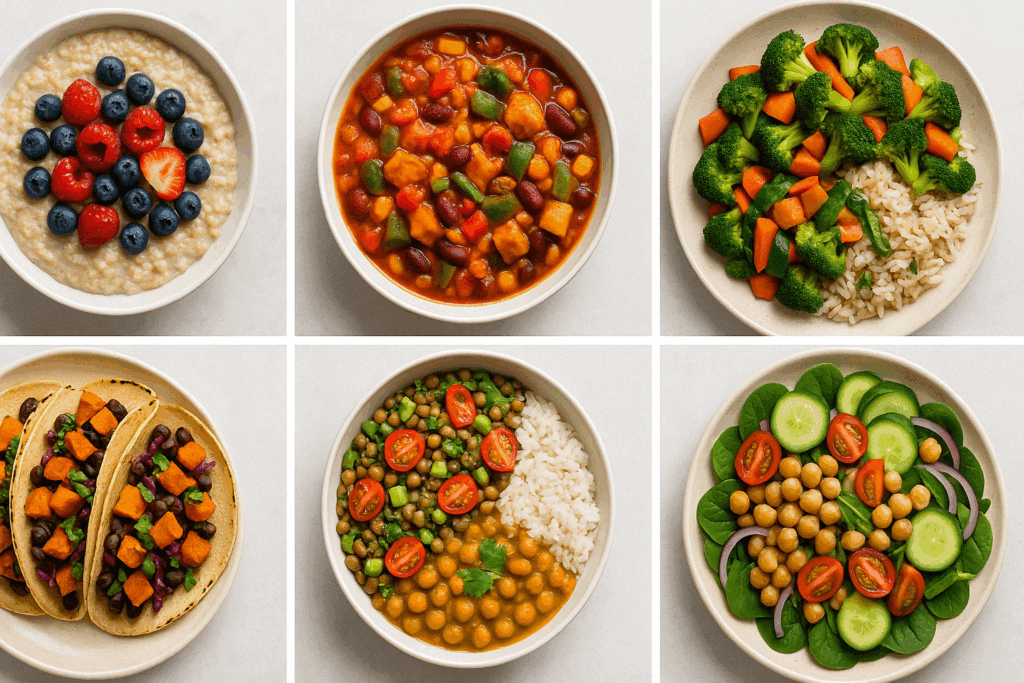Adopting a clean eating meal plan isn’t just about swapping cookies for carrots. It’s a lifestyle transformation grounded in mindfulness, science-backed nutrition, and the art of planning meals that nourish both body and mind. As more individuals seek out structured food frameworks to support their wellness goals, a growing number turn to clean eating principles to simplify the journey. At its heart, clean eating involves prioritizing whole, minimally processed foods and cutting back on artificial additives, excess sugar, and refined ingredients.
You may also like: Smart Meal Prep for Weight Loss: Expert-Approved Lunch Ideas and Recipes to Stay on Track
This article explores how a clean eating food plan can become a practical, sustainable path to better health, offering a comprehensive, science-informed weekly eating plan designed to help you eat healthy and lose weight. You’ll also discover how to adapt your food choices for real, lasting results, while comparing common dietary trends like low carb, ketogenic, and plant-based approaches in the context of clean eating. With expert insights and strategies rooted in the principles of whole-food nutrition, this is your complete guide to creating a weekly clean eating meal plan for real, measurable progress.
Understanding the Principles Behind Clean Eating
Clean eating isn’t a short-term diet or a restrictive food trend; it’s a philosophy centered on eating foods in their most natural, unrefined state. At its core, this approach emphasizes fruits, vegetables, whole grains, legumes, lean proteins, nuts, and seeds—foods that offer abundant nutrients and minimal ingredients. Processed snacks, refined sugars, and fast foods are minimized not because of arbitrary rules, but due to their lack of nutritional density and potential to disrupt metabolic health.
The strength of a clean eating food plan lies in its alignment with the body’s physiological needs. Rather than relying on highly palatable, calorie-dense meals that spike blood sugar, clean eating promotes stable energy levels, improved digestion, and sustainable weight management. For those pursuing a healthy meal plan for weight loss, this translates to consistent progress without the energy crashes or cravings that often derail success. Incorporating a healthy food meal plan into your weekly routine not only fosters weight loss but also supports immune function, cognitive clarity, and long-term disease prevention.

Designing a Healthy Meal Plan for the Week
Creating a healthy meal plan for the week starts with intentional planning. Rather than making food decisions on the fly, structure allows for balance, variety, and nutritional adequacy. A well-rounded clean eating meal plan includes all macronutrients in appropriate portions, with particular attention to fiber-rich vegetables and lean protein sources. Planning ahead also reduces the likelihood of last-minute takeout or convenience foods that don’t align with your wellness goals.
Start each week by outlining meals and snacks based on whole foods you enjoy. Think roasted sweet potatoes, sautéed greens, quinoa salads, lentil soups, chickpea stir-fries, and berry smoothies. These selections become the backbone of a food meal plan for the week that keeps you full and fueled. When planned effectively, even a simple diet plan can be incredibly powerful—especially when it prioritizes foods known to enhance satiety, regulate blood sugar, and deliver essential vitamins and minerals.
As part of a weekly eating plan, focus on incorporating variety to prevent boredom and support microbiome diversity. Rotate your greens, grains, proteins, and legumes to ensure a spectrum of nutrients. If you’re designing a healthy meal plan for weight loss, consider emphasizing volume-rich, lower-calorie foods like leafy greens and cruciferous vegetables to increase satiety without excess energy intake.
Meal Prep for Real Results
Meal prep is a foundational strategy for anyone committed to a clean eating food plan. When healthy meals are prepped and ready, it becomes far easier to make good choices consistently. A meal prep meal plan for weight loss not only saves time but reduces the likelihood of impulsive eating. By dedicating a few hours on the weekend to prep grains, chop vegetables, and cook proteins, you streamline your week and create space for mindful nourishment.
Start by preparing batch-friendly staples such as brown rice, quinoa, grilled tofu, baked tempeh, roasted root vegetables, and hearty soups. These components can be mixed and matched to create a variety of satisfying meals. With a strong plan in place, a sample food plan might include quinoa chickpea bowls with roasted broccoli, lentil vegetable stews, and colorful salads topped with sunflower seeds and tahini dressing.
For those following diet meal plans specifically for weight loss, consider portioning out meals into containers to help manage caloric intake without needing to count every calorie. This helps align your daily choices with your goals, making your diet plan food selections easier and more intuitive.

Clean Eating vs. Keto: Is a Keto Diet Sustainable?
Many people considering a clean eating lifestyle also explore popular low-carb options such as keto. But is a keto diet sustainable in the long run, and how does it compare to a clean eating approach? While ketogenic diets typically emphasize very low carbohydrate intake, high fat, and moderate protein, clean eating does not prescribe strict macronutrient ratios. Instead, it encourages balance and food quality.
The debate between ketogenic diet vs low carb plans often centers on sustainability. While a keto diet may yield rapid weight loss for some individuals, it can be challenging to maintain over time due to its restrictive nature. Clean eating, on the other hand, allows for a wider variety of food choices, making it a more adaptable and socially inclusive long-term strategy. Furthermore, many keto foods can be highly processed—think sugar-free candies or bacon-heavy recipes—which conflicts with clean eating principles.
The distinction between low carb diet keto diet variations also matters. Not all low-carb diets are ketogenic. A moderately low-carb plan that includes whole grains and legumes can still support weight loss while preserving the fiber and micronutrient content often missing from stricter ketogenic regimes. For those wondering, “Is keto a good diet compared to clean eating?” the answer depends on individual health needs, but from a long-term perspective, clean eating tends to offer broader nutritional benefits.

Daily Meal Plan to Eat Healthy and Lose Weight
A healthy diet meal plan doesn’t need to be overly complicated to be effective. For weight loss and sustained health, consistency and nutrient density matter more than calorie restriction alone. A daily clean eating plan might begin with oatmeal topped with berries and walnuts, followed by a lunch of lentil soup and a side of leafy greens, and end with a dinner of roasted vegetables and grilled tempeh. Snacks could include sliced apples with almond butter or hummus with carrot sticks.
This type of daily pattern emphasizes fiber, plant-based protein, and healthy fats, which all contribute to satiety and metabolic health. When meals are planned around whole foods, the body receives the building blocks it needs to function optimally. A simple diet plan grounded in real ingredients supports both weight loss and mental clarity, without the side effects that often accompany fad diets or extreme restrictions.
Women, in particular, often benefit from a weight loss diet plan for women that acknowledges hormonal fluctuations, iron and calcium needs, and sustainable energy levels. A clean eating plan that includes a wide variety of plant-based foods, healthy fats like avocado and chia seeds, and slow-digesting carbohydrates like sweet potatoes provides balanced nourishment without deprivation.
The Role of Mindful Eating in Clean Nutrition
While food quality and planning are crucial, how we eat matters just as much as what we eat. Mindful eating transforms the experience of nourishment into one of awareness and gratitude. It means slowing down, chewing thoroughly, eliminating distractions, and paying attention to hunger and fullness cues. When practiced regularly, mindful eating helps reduce emotional or unconscious overeating, improving the effectiveness of any healthy eating meal plan.
When coupled with a clean eating approach, mindful habits enhance digestion, regulate appetite, and foster a healthier relationship with food. This is especially important for those following diet plans for weight loss, as mindfulness helps overcome the temptation to snack impulsively or consume empty calories under stress. In essence, mindful eating allows us to listen more deeply to the body’s true nutritional needs and act accordingly.
A good meal plan supports—not controls—your lifestyle. The best meal plan for weight loss isn’t the one with the strictest rules; it’s the one that integrates seamlessly into your routines, tastes, and needs, while reinforcing your sense of self-care and balance. Whether it’s a 1 week meal plan or a year-long journey, success comes from the synergy of food quality, preparation, and mindfulness.

How to Navigate the World of Low Carb Diets
Low carbohydrate diets have become a hot topic in recent years, but understanding their nuance is essential. Many people ask, “Is keto a low carb diet?” and while the answer is technically yes, it only scratches the surface. A ketogenic diet is a specific type of low-carb plan designed to induce ketosis, a metabolic state in which the body burns fat for fuel instead of carbohydrates. But there are other ways to reduce carb intake without reaching ketosis, and these approaches may be more sustainable for the average person.
When examining keto diet vs low carb diet variations, it’s important to assess not just macronutrient breakdowns but also food quality. A clean eating low carb plan might reduce grains and sugar while still including fiber-rich vegetables, nuts, legumes, and occasional fruits. This approach offers many of the metabolic benefits associated with carb reduction while maintaining nutrient diversity and digestive health.
For some individuals, the s keto low carb format may deliver rapid results but feel difficult to maintain socially or psychologically. Others may find that a flexible clean eating plan allows them to reduce carb intake without the stress of strict tracking. It’s also worth noting that clean eating can complement low carb principles when done thoughtfully, combining the best of both worlds.
Sample Clean Eating Meal Plan for One Week
A 7 day clean eating meal plan offers structure and variety without monotony. It might begin with steel-cut oats and flaxseeds on Monday, followed by tofu stir-fry on Tuesday, and veggie chili with avocado on Wednesday. Thursday could bring chickpea curry over brown rice, while Friday includes a large rainbow salad with lentils and balsamic dressing. On Saturday, try a cauliflower rice bowl with grilled portobello, and close the week with roasted sweet potato tacos on Sunday.
This simple yet powerful plan represents a healthy diet weekly menu plan that celebrates flavor, texture, and nutritional excellence. It also accommodates diverse dietary needs and allows flexibility in portions and ingredients. For anyone seeking to create a clean eating meal plan that truly works, personalization is key. Customize meals around seasonal produce, budget, preferences, and activity level.
The Difference Between Diet and Lifestyle
While it’s easy to think of clean eating as just another diet, the real power lies in treating it as a lifestyle. Diets imply restriction and temporary change, while lifestyle shifts foster consistency and long-term wellness. When choosing between various diet meal plans, including keto and clean eating options, it’s crucial to ask: Can I do this for the rest of my life? Is this a food plan I enjoy and feel energized by?
In many cases, clean eating offers the flexibility and sustainability that other plans lack. It doesn’t require you to give up carbs completely (addressing concerns for those asking, “Is keto no carbs?”) nor does it involve confusing supplements or products. Instead, it emphasizes whole, natural foods and encourages listening to your body. This approach fosters autonomy, health literacy, and a deeper appreciation for the nourishment food provides.

Frequently Asked Questions: Clean Eating Meal Plan for Real Results
1. What makes a clean eating meal plan more effective than traditional low-calorie diets?
A clean eating meal plan offers a nutrient-dense approach that naturally promotes satiety without relying on calorie counting. Unlike many traditional diet plans, which often restrict food groups and may lead to nutrient deficiencies, clean eating emphasizes variety, fiber, and whole-food balance. This approach helps support hormone regulation, energy stability, and digestive health—all essential for long-term success. Many who follow a clean eating food plan also find improved mood and cognitive clarity, making it easier to stay consistent. This sustainable framework can be adapted into good meal plans for both maintenance and weight loss, without the yo-yo effect common in restrictive dieting.
2. How can I personalize a healthy meal plan for weight loss without feeling deprived?
Personalization is key when building a healthy meal plan for weight loss, and it begins by identifying the flavors, textures, and foods that bring you satisfaction. Incorporating a mix of cooked and raw dishes, warm spices, and seasonal produce can make your food meal plan for the week more enjoyable. Swapping restrictive meal rules for intuitive eating strategies—like checking in with hunger cues—can prevent overeating while still creating progress. You might also use an eating healthy meal planner that includes room for indulgences like dark chocolate or roasted nuts, which satisfy cravings without derailing your goals. Ultimately, the best meal plan for weight loss is one that feels both empowering and pleasurable, not punishing.
3. Are there psychological benefits to using a clean eating food plan?
Yes, the psychological benefits of a clean eating food plan are often underestimated. Structured, mindful eating reduces decision fatigue and helps eliminate the stress and guilt frequently associated with diet meal plans. By focusing on nourishing rather than restricting, individuals build healthier relationships with food and reduce binge-eating triggers. This mindset shift can support mental clarity and emotional resilience, particularly for those juggling busy schedules. In the long term, a clean eating approach cultivates a lifestyle of self-trust and balance, which is essential for sustaining any healthy food plans over time.
4. How does a clean eating approach compare to a ketogenic diet for long-term results?
While both clean eating and ketogenic diets can lead to weight loss, they differ significantly in sustainability and flexibility. A clean eating meal plan allows for a broader range of food groups, including fiber-rich carbohydrates and legumes, which are often excluded from keto. Many people find keto difficult to maintain due to its restrictive nature, especially when it comes to social dining or travel. On the other hand, clean eating meal plans for weight loss prioritize minimally processed foods without eliminating entire macronutrient categories. For individuals looking to adopt a healthy diet weekly menu plan with lasting benefits, clean eating often proves more adaptable and inclusive.
5. What role does meal prep play in staying consistent with a healthy food meal plan?
Meal prep is the backbone of consistency for any healthy food meal plan. It eliminates daily guesswork, reduces reliance on takeout, and provides reassurance that nutritious options are always within reach. A meal prep meal plan for weight loss is especially helpful when navigating workdays, social events, or moments of low motivation. Prepping staple ingredients like roasted vegetables, cooked legumes, and whole grains ensures you can quickly assemble satisfying meals without resorting to convenience foods. When meal prep is part of your routine, your weekly eating plan becomes a reliable tool for accountability and momentum.
6. Can clean eating be combined with an exercise food plan to maximize results?
Absolutely. Clean eating synergizes well with an exercise food plan by ensuring your body receives adequate fuel for performance, recovery, and lean muscle maintenance. Consuming whole foods rich in antioxidants, vitamins, and minerals can reduce inflammation, support joint health, and improve endurance. Timing meals around workouts—such as pairing carbohydrates and protein post-exercise—enhances recovery and muscle protein synthesis. Integrating a clean eating meal plan into your workout routine doesn’t just improve physical results; it also enhances mood and mental focus during training. Together, food and movement form a powerful foundation for sustainable health.
7. How can I transition from fad diets to a more sustainable simple diet plan?
The transition begins with a mindset shift—choosing progress over perfection and sustainability over restriction. Instead of jumping into rigid programs, start by building a 1 week meal plan rooted in whole foods you already enjoy. Avoid detoxes or short-term trends and instead focus on developing a healthy eating meal plan that includes a wide variety of nutrients. You might also keep a journal to track how different foods make you feel physically and emotionally, guiding your choices over time. By gradually adopting healthy food plans that feel achievable, you set the stage for lifelong wellness.
8. Are there special considerations for building a weight loss diet plan for women?
Yes, a weight loss diet plan for women should be tailored to hormonal fluctuations, reproductive health, and nutrient density. Iron-rich foods like lentils, spinach, and pumpkin seeds can support energy levels and prevent deficiency, while calcium and magnesium are crucial for bone health. A healthy diet meal plan for women should also include adequate protein to support lean mass and metabolic rate, particularly during perimenopause and menopause. Emotional eating patterns, often shaped by societal pressures, can also be addressed through an eating healthy meal planner that emphasizes self-compassion. When crafted thoughtfully, healthy meal plans for women can address both physiological needs and psychological well-being.
9. What are the benefits of using a sample food plan as a starting point?
A sample food plan provides structure and inspiration, particularly for those new to clean eating. It serves as a template for building balanced meals, offering examples of how to pair ingredients for taste and nutrition. From there, individuals can adapt based on cultural preferences, allergies, or specific goals like plant-based eating or gluten-free needs. Using a sample food plan can also reduce decision fatigue, making it easier to follow a healthy meal plan for the week without constant planning. Over time, these examples evolve into personalized food routines that reflect your lifestyle, making clean eating second nature.
10. How do I evaluate whether my current food plan is actually working for me?
Beyond weight changes, a successful food plan supports your energy, sleep quality, digestion, and mental clarity. Pay attention to how you feel after meals—sustained energy and minimal cravings are good signs of metabolic balance. A healthy diet meal plan should also support your daily routine without creating unnecessary stress or obsession. If you’re frequently thinking about food, feeling deprived, or struggling with bloating or fatigue, it may be time to revise your approach. Evaluating your food plan isn’t just about physical outcomes but about creating a lifestyle that nourishes your full self—body, mind, and spirit.

Concluding Thoughts: How a Clean Eating Meal Plan Supports Real, Lasting Results
Choosing a clean eating meal plan is more than just another attempt to drop a few pounds. It’s a comprehensive, nourishing, and sustainable path to better health. Through careful weekly planning, mindful meal preparation, and balanced nutrient intake, clean eating offers structure without rigidity, and results without deprivation. Whether your goal is weight loss, improved energy, or greater overall health, a healthy food plan grounded in whole ingredients and intentional habits provides the foundation.
When compared to restrictive diets like keto, clean eating supports a more inclusive and long-term vision of wellness. While the ketogenic diet vs low carb debate continues, it’s clear that the healthiest outcomes come from consistency, quality, and self-awareness. Clean eating is not anti-fat, anti-carb, or anti-pleasure—it’s pro-nourishment, pro-balance, and pro-longevity.
By following a healthy eating meal planner tailored to your lifestyle, you can reclaim control over your health without the confusion of conflicting trends. Whether you’re starting with a 1 week meal plan or developing a full healthy meal plan for the week, what matters most is your ability to stick with it and thrive. With real food, real planning, and real results, clean eating becomes not just what you do—but who you are becoming.
Was this article helpful? Don’t let it stop with you. Share it right now with someone who needs to see it—whether it’s a friend, a colleague, or your whole network. And if staying ahead on this topic matters to you, subscribe to this publication for the most up-to-date information. You’ll get the latest insights delivered straight to you—no searching, no missing out.
Further Reading:
Clean-Eating Meal Plan for Beginners, Created by a Dietitian
14-Day Clean-Eating Meal Plan Created by a Dietitian: 1,200 Calories
Disclaimer
The information contained in this article is provided for general informational purposes only and is not intended to serve as medical, legal, or professional advice. While NewsHealthWatch strives to present accurate, up-to-date, and reliable content, no warranty or guarantee, expressed or implied, is made regarding the completeness, accuracy, or adequacy of the information provided. Readers are strongly advised to seek the guidance of a qualified healthcare provider or other relevant professionals before acting on any information contained in this article. NewsHealthWatch, its authors, editors, and contributors expressly disclaim any liability for any damages, losses, or consequences arising directly or indirectly from the use, interpretation, or reliance on any information presented herein. The views and opinions expressed in this article are those of the author(s) and do not necessarily reflect the official policies or positions of NewsHealthWatch.

